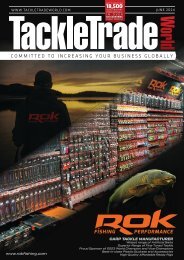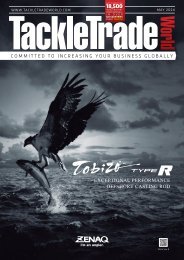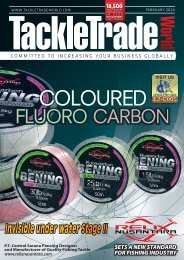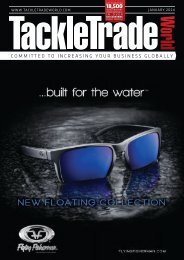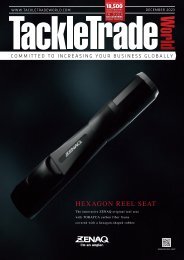Tackle Trade World - October 2023
You also want an ePaper? Increase the reach of your titles
YUMPU automatically turns print PDFs into web optimized ePapers that Google loves.
SPOTLIGHT ON...<br />
LINE<br />
SPOTLIGHT ON<br />
LINE<br />
Whatever your style of fishing, there’s a good chance there’s a specific line for that – from<br />
monofilament and fluorocarbon through to copolymers, various ’stranded’ braids, fused lines<br />
and more. But what are fishing lines and how do you select the correct one for the job?<br />
You can catch fish without a rod and<br />
with no reel, you can even catch<br />
fish without a hook, but without<br />
line?<br />
Since time immemorial, fishing line<br />
has been a vital part of a fisherman’s<br />
setup. Archaeologists have found ancient<br />
Egyptian art representing fishermen<br />
catching fish with a rod, line and fishing<br />
hook that dates from 2,000BC, while the<br />
Chinese used line made of silk for angling<br />
as far back as the fourth century and cat<br />
gut was used just a couple of hundred years<br />
ago.<br />
But the real change came back in 1938<br />
when Du Pont chemists invented nylon<br />
and made braided nylon line a year later,<br />
although it wasn’t until the 1950s that the<br />
first polyester fishing lines were produced<br />
under the name Dacron.<br />
In 1959 Du Pont introduced Stren, a<br />
thinner mono, ideal for fishing reels and<br />
spinning methods.<br />
Today lines are almost all made of<br />
synthetic materials including nylon,<br />
polyvinylidene fluoride, polyethylene,<br />
copolymers, fluorocarbon and Dacron.<br />
MONOFILAMENT<br />
Most fishing line is made from<br />
monofilament because of its strength,<br />
availability in all pound-test ratings and<br />
low cost. It is typically made from nylon by<br />
melting and mixing polymers, which are<br />
then extruded through tiny holes, forming<br />
strands that are then spun into spools of<br />
various thicknesses. The extrusion process<br />
controls not only the thickness of the line<br />
but also the pound test of the line.<br />
It can have various characteristics,<br />
too, and can be produced in a variety of<br />
breaking strains and diameters, not to<br />
mention colours.<br />
FLUOROCARBON<br />
Developed in the 1960s, originally<br />
fluorocarbon lines were used for saltwater<br />
fishing but they are now very popular<br />
with freshwater anglers since they<br />
become almost invisible underwater. They<br />
are also much denser than mono lines,<br />
meaning they’re a good choice if you need<br />
something that sinks quickly.<br />
However, they are also stiff and hard<br />
to control when on a reel, meaning they<br />
don’t cast as well as other lines, don’t<br />
hold knots as well, have low stretch and a<br />
comparatively large diameter.<br />
Fluorocarbon is made through the same<br />
extrusion process as mono, however the<br />
difference is the molecular level, being<br />
extruded from polyvinylidene difluoride,<br />
which is far more compact than nylon. This<br />
also makes fluorocarbon inherently heavier<br />
and creates different refraction properties<br />
in water.<br />
BRAID<br />
The braided line market has boomed in<br />
recent years, mainly because the fibres that<br />
make up the line have increased in strength<br />
and abrasion resistance.<br />
Braids also possess very high knot<br />
strength, a complete lack of stretch and great<br />
overall power in relation to their diameter.<br />
They are produced by braiding or weaving<br />
fibres of a man-made material like Spectra<br />
or micro-Dyneema into a strand of line.<br />
Being abrasion-resistant and with<br />
minimal stretch, they are great for shy-biting<br />
fish, as any contact will be felt directly by the<br />
angler, while their suppleness enables them<br />
to be cast long distances.<br />
Unlike mono, they have no memory and<br />
so can last a while in storage.<br />
One disadvantage of braid is that it does<br />
not sink really well.<br />
Braided line is also becoming more<br />
popular with big-game saltwater anglers,<br />
thanks to its low stretch and high abrasion<br />
resistance properties.<br />
COPOLYMER LINES<br />
Produced by combining at least two<br />
different materials together, the finished<br />
product is a single filament but they<br />
typically have different characteristics from<br />
traditional monos and these will depend<br />
on the materials used.<br />
Often stronger yet thinner than regular<br />
monofilament, most offer less less stretch<br />
and more memory plus low visibility.<br />
FUSED LINES<br />
Made from the same fibres as braided line<br />
but the strands are fused or glued together<br />
while still hot, rather than being woven<br />
together. Fused lines are exceptionally<br />
slick and thin for their strength, boasting<br />
minimal stretch and high abrasion<br />
resistance. Their thin diameter and<br />
incredible strength make them an ideal<br />
choice when fishing around vegetation or<br />
for skipping baits under boat docks.<br />
32 www.tackletradeworld.com





